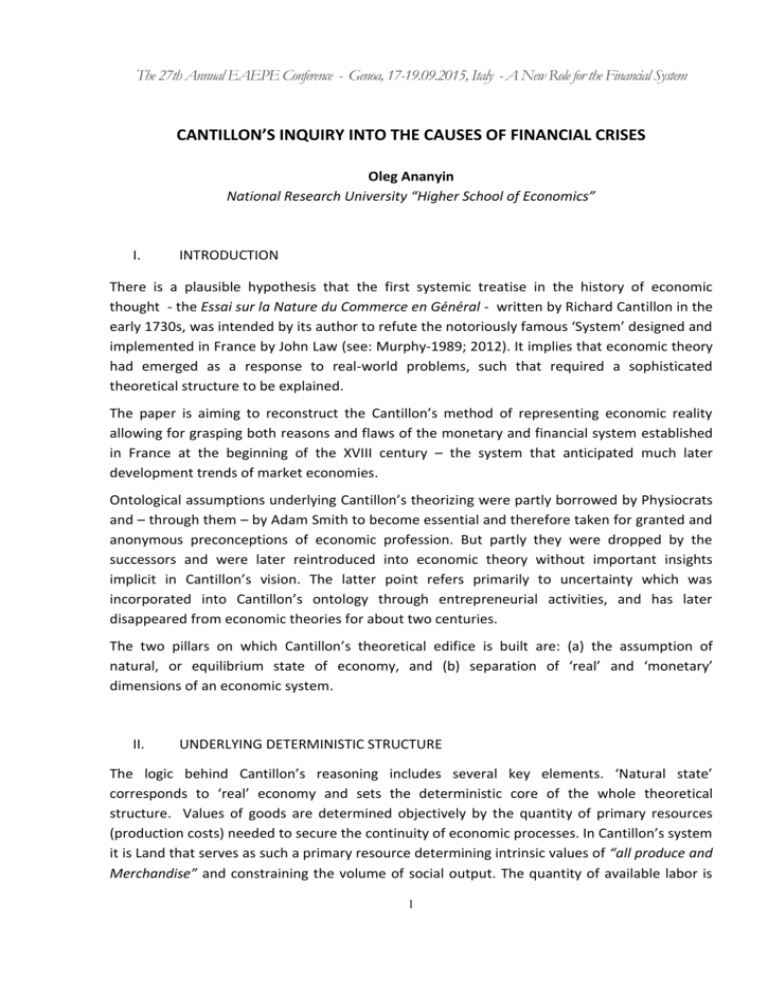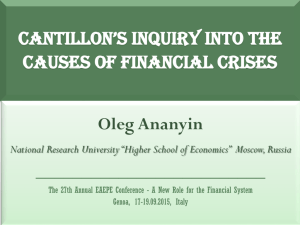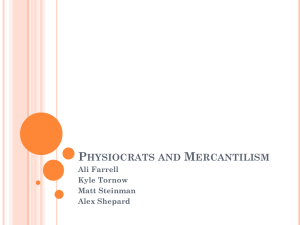EAEPE_15_Ananyin
advertisement

The 27th Annual EAEPE Conference - Genoa, 17-19.09.2015, Italy - A New Role for the Financial System CANTILLON’S INQUIRY INTO THE CAUSES OF FINANCIAL CRISES Oleg Ananyin National Research University “Higher School of Economics” I. INTRODUCTION There is a plausible hypothesis that the first systemic treatise in the history of economic thought - the Essai sur la Nature du Commerce en Général - written by Richard Cantillon in the early 1730s, was intended by its author to refute the notoriously famous ‘System’ designed and implemented in France by John Law (see: Murphy-1989; 2012). It implies that economic theory had emerged as a response to real-world problems, such that required a sophisticated theoretical structure to be explained. The paper is aiming to reconstruct the Cantillon’s method of representing economic reality allowing for grasping both reasons and flaws of the monetary and financial system established in France at the beginning of the XVIII century – the system that anticipated much later development trends of market economies. Ontological assumptions underlying Cantillon’s theorizing were partly borrowed by Physiocrats and – through them – by Adam Smith to become essential and therefore taken for granted and anonymous preconceptions of economic profession. But partly they were dropped by the successors and were later reintroduced into economic theory without important insights implicit in Cantillon’s vision. The latter point refers primarily to uncertainty which was incorporated into Cantillon’s ontology through entrepreneurial activities, and has later disappeared from economic theories for about two centuries. The two pillars on which Cantillon’s theoretical edifice is built are: (a) the assumption of natural, or equilibrium state of economy, and (b) separation of ‘real’ and ‘monetary’ dimensions of an economic system. II. UNDERLYING DETERMINISTIC STRUCTURE The logic behind Cantillon’s reasoning includes several key elements. ‘Natural state’ corresponds to ‘real’ economy and sets the deterministic core of the whole theoretical structure. Values of goods are determined objectively by the quantity of primary resources (production costs) needed to secure the continuity of economic processes. In Cantillon’s system it is Land that serves as such a primary resource determining intrinsic values of “all produce and Merchandise” and constraining the volume of social output. The quantity of available labor is 1 The 27th Annual EAEPE Conference - Genoa, 17-19.09.2015, Italy - A New Role for the Financial System an endogenous variable dependent on the capacity of land to feed the inhabitants of the country. The consumption level of the population is taken as given by the customs of a country, rather than in physical terms. Cantillon was explicit not to deal with this issue: “It is …a question outside of my subject whether it is better to have a great multitude of Inhabitants, poor and badly provided, than a smaller number, much more at their ease: a million who consume the produce of 6 acres per head or 4 millions who live on the product of an Acre and a half” (Cantillon 1931[1755]: 85). Either by commands or by the forces of competition economic system tends to gravitate towards the ‘natural state’, or equilibrium. Exchange or monetary economy is introduced as a possible alternative to a kind of ‘command’, or – rather – traditional estate economy. Cantillon’s natural state is in this sense independent of an institutional set-up. Market forces are conceived as but a mechanism pushing economy towards this predetermined state by reconciling the two givens shaping, correspondingly, supply and demand. It is notable that the solution of this problem is achieved in the Essai without “reliance on natural laws or… obfuscatory metaphors such as the ‘invisible hand’” (Murphy 1989: 257), and at least for this reason is superior to that of Adam Smith. III. MARKET AS A LOCUS OF UNCERTAINTY To make his deterministic theory plausible Cantillon placed it into a framework with uncertain environment and mechanisms of adaptation to uncertainties. “There is never a variation in intrinsic values, but the impossibility of proportioning the production of merchandise and produce in a State to their consumption causes a daily variation, and a perpetual ebb and flow in Market Prices” (Cantillon 1931[1755]:31). Thus the two institutional set-ups differ in the way how they deal with uncertainty entering the scene through the gap between actual and ‘natural state’. It is here that an entrepreneur enters the game. The market mechanism is driven by various types of middlemen-entrepreneurs responsible for the adaptation of production possibilities to changing manners of the final consumers. The shift from an estate to an exchange economy consists in replacing the ‘overseers’ of the former with the independent entrepreneurs of the latter, in which case independence means bearing the burden of uncertainty caused by any deviation from the ‘natural state’. Circular flow of social product is conceived as a complicated structure of commodity flows ramifying while passing from large-scale producers and wholesale traders to small shopkeepers, as well as of corresponding money flows through which “all the small amounts are then collected to make payments in large amounts”(Ibid., ch. II-3). The mechanism is not assumed to work smoothly. Cantillon admitted that “It often happens that Sellers who are too obstinate in keeping up their price in the Market, miss the opportunity of selling their Produce or Merchandise to advantage and are losers thereby”, and – in more general terms – that “[the] method of fixing Market prices has no exact or geometrical foundation, since it often depends 2 The 27th Annual EAEPE Conference - Genoa, 17-19.09.2015, Italy - A New Role for the Financial System upon the eagerness or easy temperament of a few Buyers or Sellers, it does not seem that it could be done in any more convenient way” (Ibid.: 121, 119). Nevertheless he believed that “in well organized Societies the Market Prices of articles whose consumption is tolerably constant and uniform do not vary much from the intrinsic value.” (Ibid.: 31). IV. MONETARY SYSTEM AS A LOCUS OF MANIPULATIONS Exchanges imply money; hence exchange economy is conceived as monetary, and all deviations from ‘natural state’ take monetary form. They are due either to imperfections in entrepreneurs’ responses to market demand, or to harmful monetary regulations, i.e. in each case these deviations have human origin. However, unlike entrepreneurs’ failures for which they are fully responsible, effects of monetary regulations are due to governmental, or power, agencies and tend to charge burden on a broader public. Cantillon identified at least two spheres where such effects could be observed: manipulations with exchange rates under bi-metallic monetary regimes, and what he calls ironically “refinements of credit” – practices became known during Great Bubbles of the early XVIII century, including that of Law’s ‘System’. In Part Three of the Essai Cantillon presents careful analysis of “strange variations” of price levels occurred in France and caused by conscious manipulations of exchange proportions between gold and silver, and of their effects upon foreign trade and income distribution. His conclusion was to assert that “The King makes a considerable profit…, but it costs France three times as much to enable him to make this profit” (p.293). In the final chapter of his book Cantillon turned his attention directly to governmental regulations of financial systems in times of Great Bubbles. Having revealed the mechanisms governing social interactions behind the circular flow of social product, he could tackle his main problem – to show the flaws of John Law’s system. His method remained the same: he defined the channels through which human agents – in this case governmental agencies – could influence economic processes and indicated limits of this influence. In relation to Law’s system it was the introduction of a public bank that created new instruments of manipulations. Cantillon showed that financial innovations led to a widening of the gap between the natural state and actual state of affairs. His final conclusion was straightforward: … It is then undoubted that a Bank with the complicity of a Minister is able to raise and support the price of public stock and to lower the rate of interest in the State at the pleasure of this Minister when the steps are taken discreetly, and thus pay off the State debt. But these refinements which open the door to making large fortunes are rarely carried out for the sole advantage of the State, and those who take part in them are generally corrupted. The excess banknotes, made and issued on these occasions, do not 3 The 27th Annual EAEPE Conference - Genoa, 17-19.09.2015, Italy - A New Role for the Financial System upset the circulation, because being used for the buying and selling of stock they do not serve for household expenses and are not changed into silver. But if some panic or unforeseen crisis drove the holders to demand silver from the Bank the bomb would burst and it would be seen that these are dangerous operations. (Ibid.: 323). V. CONCLUSION: CANTILLON’S ANTICIPATIONS In order to reveal the flaws of Law’s ‘System’ Richard Cantillon had to construct a theoretical structure which laid the groundwork for future developments of economic theories. The idea of the circular flow of social product became the core of the famous ‘Tableau Economique’. The idea of ‘immutable laws of production’ (J.S. Mill’s term) as a kind of benchmark around which actual economic activities tend to gravitate served the common ground to both Classical political economy and much of neoclassical theorizing. Dichotomy of real/monetary phenomena, Knightian entrepreneurs, Pasinetti’s pre-institutional framework of economic analysis, – all these concepts and approaches have their evident predecessors in Cantillon’s Essai. And, finally, recent theories of financialization can also be traced back to Cantillon’s analysis of “the refinements of credit”. He was the first to show that a financial system is such a superstructure over ‘real’ economy that may be treated to be ‘neutral’ only in the abstract, not in grasping phenomena of the real world. Moreover, assessing recent experiences of the Great Bubbles Cantillon became aware of the possibility that a financial system inhabited with people pursuing their private purposes can acquire certain – although limited – degree of independence from the ‘real’ sector as its base, and perceived this possibility to be socially dangerous. References Cantillon, R. (1931/1755). Essai sur la nature du commerce en général. Ed. by H. Higgs. London: Macmillan. Murphy, Antoin E. (1989). Richard Cantillon: Entrepreneur and Economist. Oxford: Oxford University Press. Murphy, Antoin E. (2012). Cantillon revisited / Classical Political Economy and Modern Theory. Essays in Honour of Heinz Kurz. L. and NY: Routledge. 4










